037 - Hazardous Fuels Reduction Using Flame Cap Biochar Kilns
Introduction
Warning: Fire use requires extreme caution.
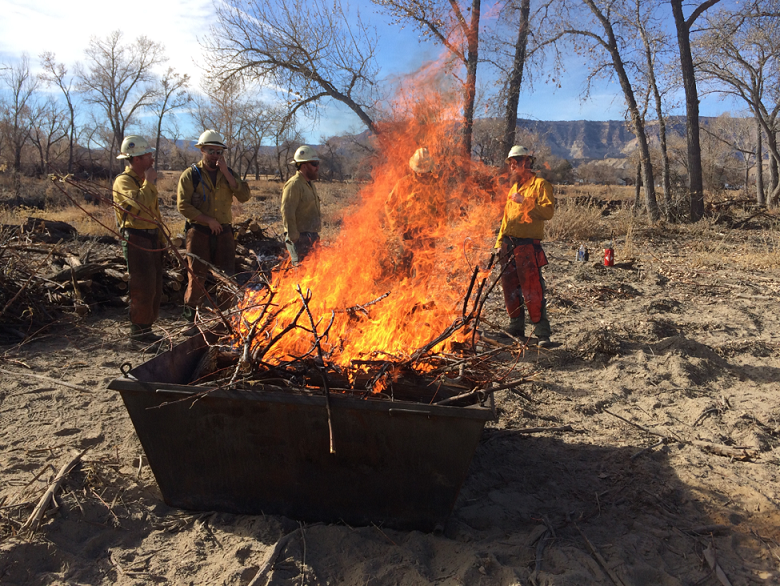
Figure 1. Metal biochar kiln processing feedstock in Utah.
Hazardous fuels are a problem across the West. From 2000-2017, bark beetles affected 85,000 square miles of forests in the western U.S. (an area the size of Utah). The accumulation of this beetle-killed timber occupies many forested slopes, posing a fire risk to citizens, landscapes, and nearby infrastructure. Additionally, invasive species such as Russian olive (Elaeagnus angustifolia L.) and tamarisk (Tamarix spp.) choke streams and rivers and prevent native species from growing and supporting the ecosystem. The accumulation of beetle-killed timber and invasive species not only creates hazardous fuels, but as they decay, greenhouse gases (carbon dioxide and methane) are released into the atmosphere. To deal with this excess fuel, foresters remove trees generating large quantities of “waste wood”. This waste wood, commonly called slash is often piled and burned (known as pile burning), releasing stored carbon and other greenhouse gases into the atmosphere (figure 2). While effective for dealing with large quantities of slash, pile burning results in extreme heat pulses into the ground, which has negative consequences on the physical, chemical, and mineralogical properties of the soil under the slash piles (Arocena & Opio, 2003; Jiménez Esquilín, Stromberger, Massman, Frank, & Shepperd, 2007). An innovative alternative to this approach utilizes fire to dispose of slash, but contains the fire in simple metal kilns (figure 3). When compared to the pile burning method, this approach produces considerably less smoke, does less damage to the soil, is safer, extends the season possible for fuel reduction efforts, sequesters carbon, and yields biochar, a charcoal-like product made from organic material.
What is Biochar?
Biochar is the result of the thermochemical separation that occurs when biomass is fired to temperatures ranging from 400 to 600 degrees C. Because of biochar’s high porosity and surface area, when added to soil, it increases water-holding capacity, making it available to plants over an extended period of time (Karhu, Mattila, Bergström, & Regina, 2011; Tryon, 1948). Biochar as a soil amendment dates back 7,000 years where it was used to improve nutrient-deficient Amazonian soil known as “Terra Preta de Indios” (Lal, 2009). Tapping into biochar as a means for soil carbon storage may be a useful way to mitigate climate change (Batista et al., 2018). The Utah Biomass Resources Group has demonstrated a practical method for producing biochar using simple metal kilns that:

Figure 2. Typical hand-ignited slash piles. Photo courtesy of the National Park Service.

Figure 3. Metal biochar kiln processing feedstock.
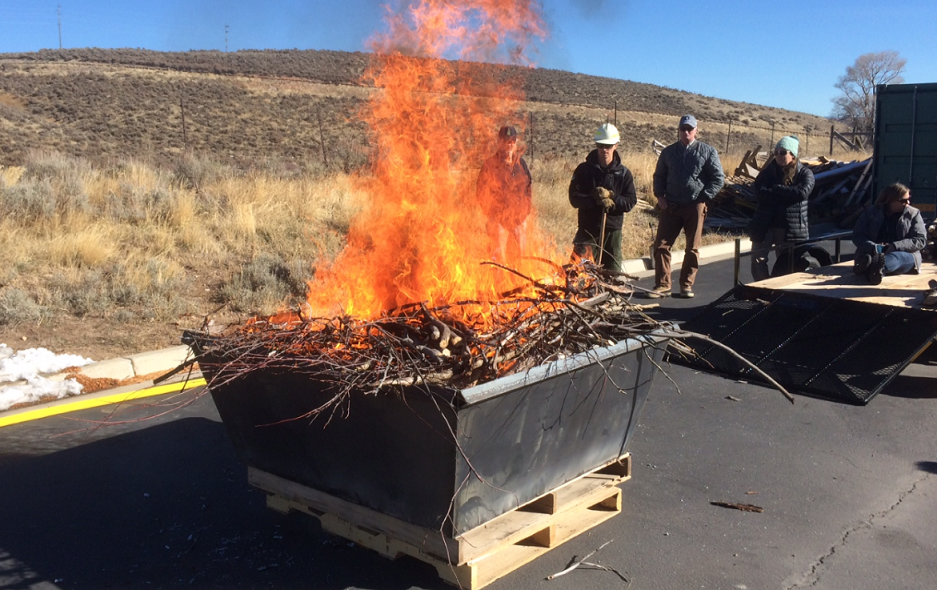 Figure 4. Demonstration that biochar can be made in a parking lot, or in the forest.
Figure 4. Demonstration that biochar can be made in a parking lot, or in the forest.
- give people an easy way to mitigate fire danger both affordably and locally,
- help citizens take fuel reduction projects into their own hands in wildland and rural settings, and
- create biochar, a valuable product with many benefits.
By carefully following fire escape precautions (as described below), these techniques are appropriate in the wildland-urban interface zone, where many people reside. The danger of introducing fire in this environment requires an abundance of caution, preparation, and planning; however, under favorable weather and fuel moisture conditions and by following a few simple guidelines, anyone can make biochar.
| Effects | Metal Kilns | Pile Burning |
|---|---|---|
| Smoke Impacts | Flame cap technique contains the combustion, which burns feedstock more efficiently, creating less smoke. | Pile burning simply burns entire feedstock piles in unregulated way, this creates significantly more smoke. |
| Soil Impacts | Containing the fire in a metal kiln creates a barrier between the heat and soil, buffering and protecting the soils from extreme heat pulses. | Piling and burning occurs directly on the soil surface. The consequences to the forest floor can be extremely detrimental to soil structure and microorganisms |
| Value Added Product | Using kilns creates biochar, a valuable product for soil carbon sequestration, and amending soils | Piling and burning does not result in any value-added product. |
Metal Kilns
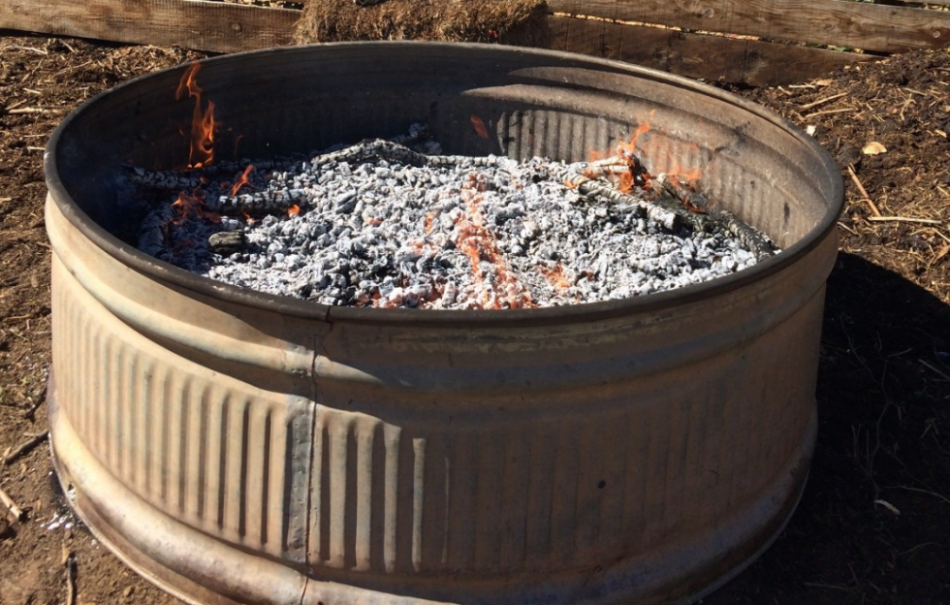
Figure 5. Making biochar using a simple metal stock tank.
Metal Kilns There are infinite varieties of kiln shapes and sizes for making biochar. We have adopted the “Oregon Kiln”, or flame cap kiln made from 14-gauge steel. The kilns described in this process are 5’ by 5’ by 2’ deep, they weigh approximately 200 lbs., and can easily be carried by four strong people. Kilns are tapered at the bottom, which makes them easy to stack and transport. The flame cap kilns work well for forestry operations because they are portable and maneuverable in the woods. Forestry crews report that these simple kilns maintain their durability, even after more than 100 firings. Kilns can be made using a variety of styles using simple, metal materials (figure 5). With open source plans, welding shops in Utah manufacture flame cap kilns for approximately $800 (figure 6). The capacity of the kilns described here cannot tackle the size and complexity of the current hazardous fuels problem in the West today. However, burning local waste-wood in a flame cap kiln can make an impact on the edges of communities where fuel reduction efforts are needed and easy to access.
Location and Timing
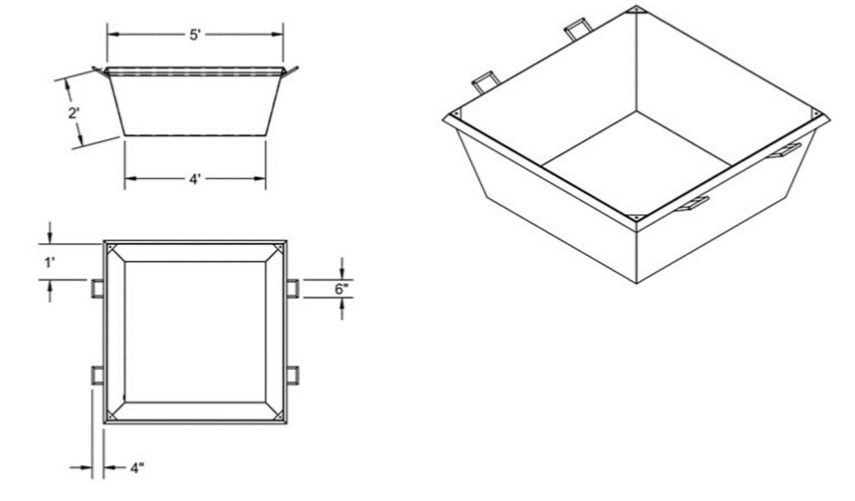
Figure 6. Open source plan for building biochar kiln.
Only personnel from appropriate public agencies are legally permitted to operate kilns on public lands. The kilns and techniques described here are appropriate to use on private land; however, extreme caution should be taken to avoid an accidental wildfire. Even on private land, fire restrictions and burning permits are required. Consult with fire agency personnel; consider weather and surrounding fuel conditions and fire preparedness long before attempting to make biochar. Although this approach contains the flames within a box, there is ample opportunity for escaped embers to start an unwanted fire. Do not operate kilns in windy conditions, or near extremely dry fuel sources, including yards and homes. Each situation is different and should be evaluated on a case by case basis.
Safety
One of the benefits of the flame cap kilns is their mobility (figure 7). Kilns are easily moved and can be used in the forest where the biomass is located, eliminating the costly expense of feedstock transportation (figure 6). Making biochar in the forest requires the creation of a diligent fire safety plan. To avoid the risk of accidental ignition:

Figure 7. Flame cap biochar kilns stacked and ready for transport.
- Place kilns where the flames will not impinge on nearby vegetation, flammables, overhead obstructions, or other hazards.
- Avoid operating kilns in windy conditions to prevent embers from starting unwanted fires.
- Prepare the site with hand tools or machinery to ensure kilns will rest on level ground.
- Dig a trail or firebreak around the kilns to contain any burning material that may fall out of the kiln.
- Have an active water source readily at hand e.g. fully-charged hose for knocking down embers and spot fires that result from embers. Be prepared to deal with rapidly moving firebrands and sparks carried by unexpected winds.
- Have a shovel, Pulaski and a chain saw on hand to extinguish unwanted fire starts.
- Wear proper personal protective gear, preferably fire retardant clothing. At minimum, participants should wear leather gloves, boots, and eye protection. Choose cotton clothing and avoid wearing polyester.
- Communicate with your local fire authorities and inform them of operations, including contingency plans.
- Use care and proper form when moving the kilns, as they are heavy and moving them can cause injury, especially when full of coals and water (do not move a kiln that is full of water, drain or dump first).
Feedstock Preparation
Feedstock preparation In Utah, we used the flame cap kilns for making biochar from juniper, pinyon, aspen, Douglas-fir, tamarisk, and Russian olive. Feedstock preparation is more important than species. For the most efficient burn, use the driest feedstock possible. Cut feedstock into lengths slightly smaller than the kiln length to maximize space and kiln capacity. Sort and stack feedstock into roughly three diameter classes with small diameter sticks (small kindling) in one pile, medium in another (up to 4 inch diameter), and large in another (up to 8 inches in diameter). This organization will help when loading the kiln (figure 8).


Figures 8 and 9. Examples of feedstock size separation.
Initial Kiln Loading
Place the kiln on a flat surface that can withstand heat (not directly on pavement) and ensure there is no flammable material within 100 feet of the kiln. Begin by filling the kiln with dry branches and logs from the large pile, followed by the medium pile, layering them in a crisscross pattern (figure 9). Then pile small, dry sticks (kindling) on top of the logs and light the kiln from the top (figure 10). This technique will soon form a ‘cap’ of flames across the top of the kiln. Maintaining the flame cap is an important part of the process; as combustibles rise through the flame cap, they are consumed by the flames, resulting in a very clean burn.
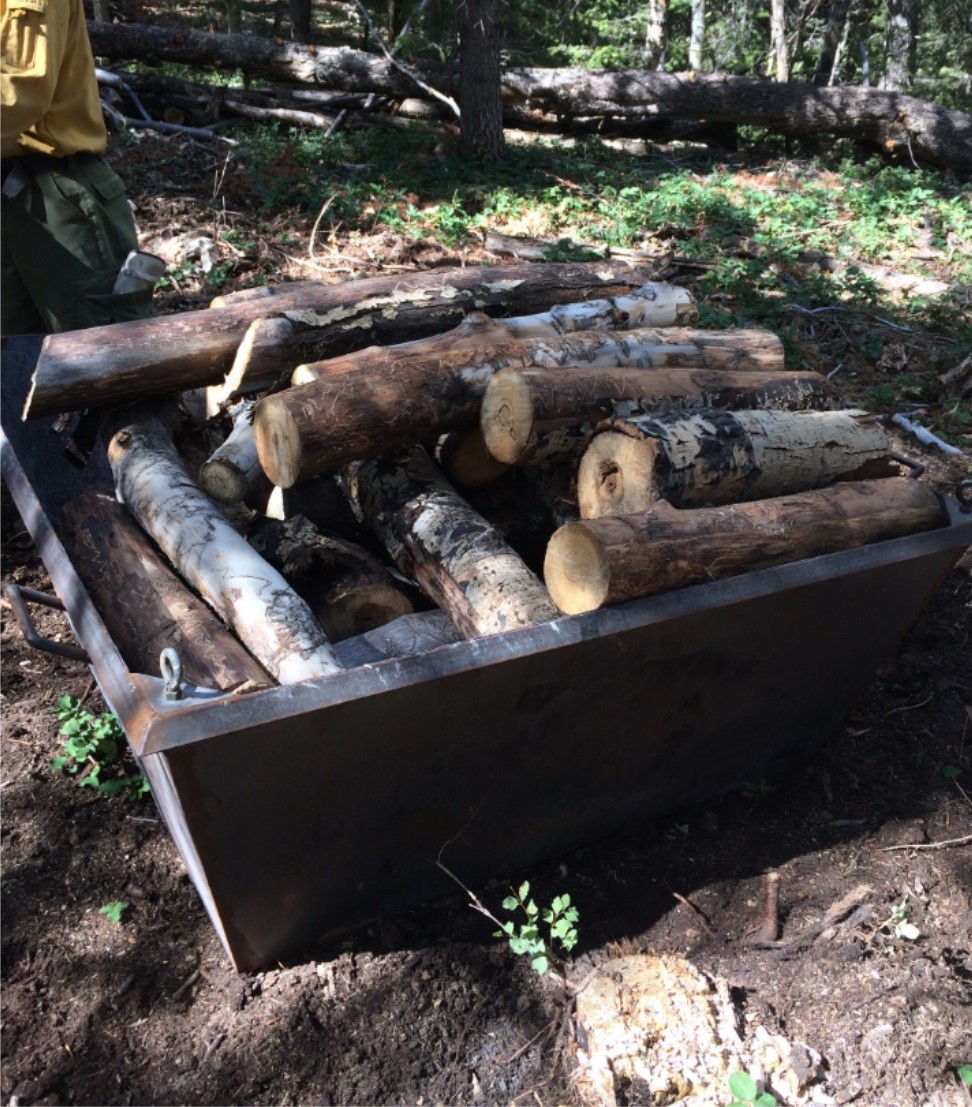
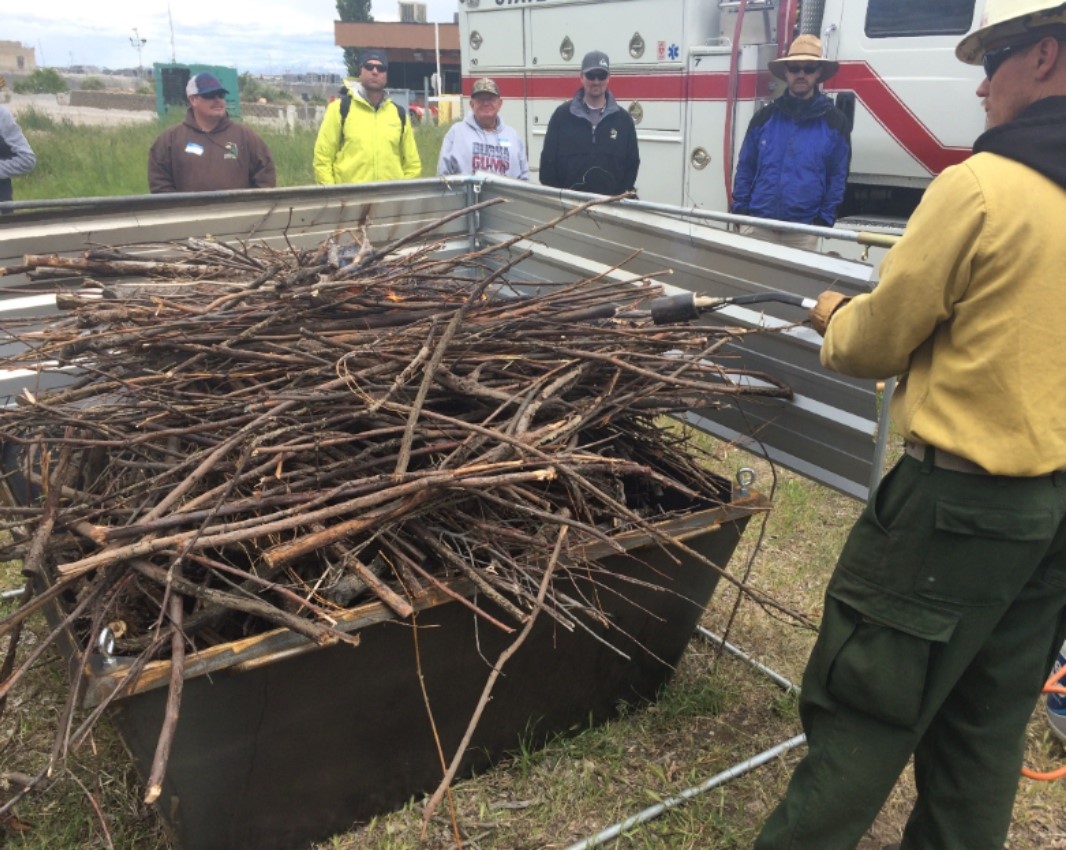
Figures 10 and 11. Demonstration of how to load a kiln.
Kiln Operation
Keep loading the kiln with pre-cut feedstock over the next 2 to 4 hours (figures 11, 12, 13). Depending on the condition of the fire, adjust the timing, quantity and size of feedstock that is added. For example, if the fire is not burning well, use smaller, drier material to stoke it. If it is burning well, add larger diameter material to use up the most biomass. When fuels are wet, or when the humidity is high, consumption rates will be reduced. In ideal conditions (over four-hour period), the kiln is likely to consume 4-5 times its own volume. When the weather and fuels are very dry, the kiln can consume more than eight times its own volume. Keep adding material as it burns down (while maintaining the flame cap) until the kiln is at least three-fourths full of coals.
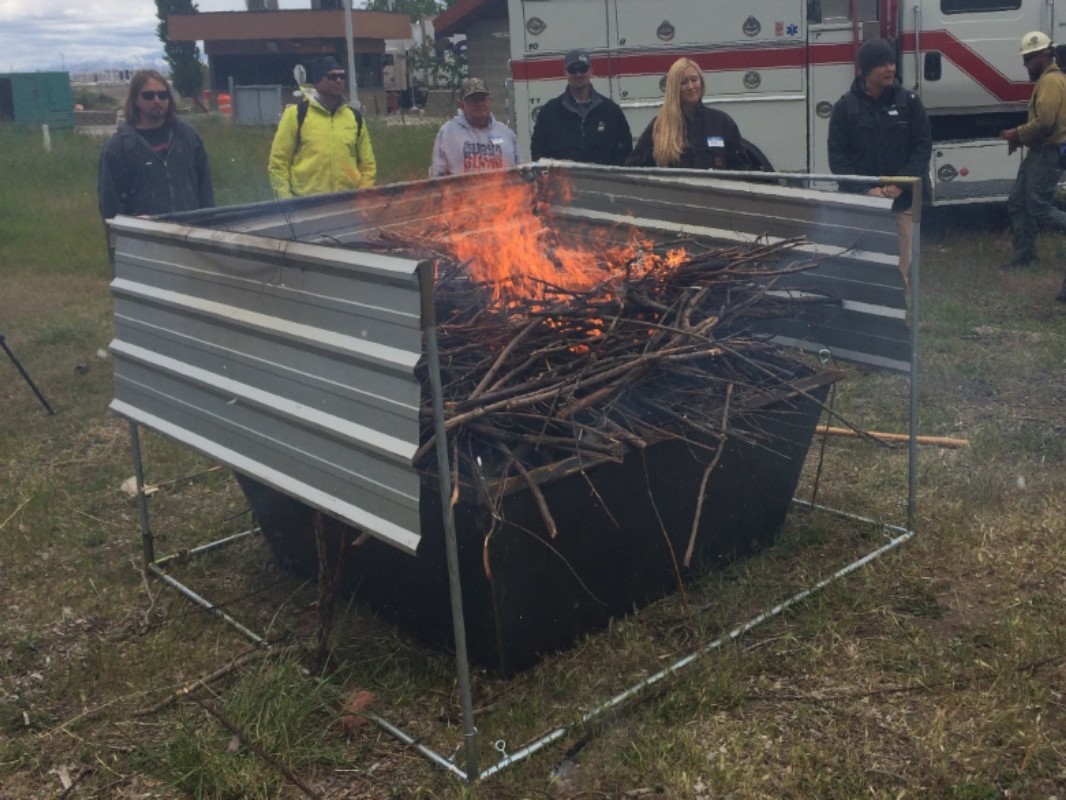
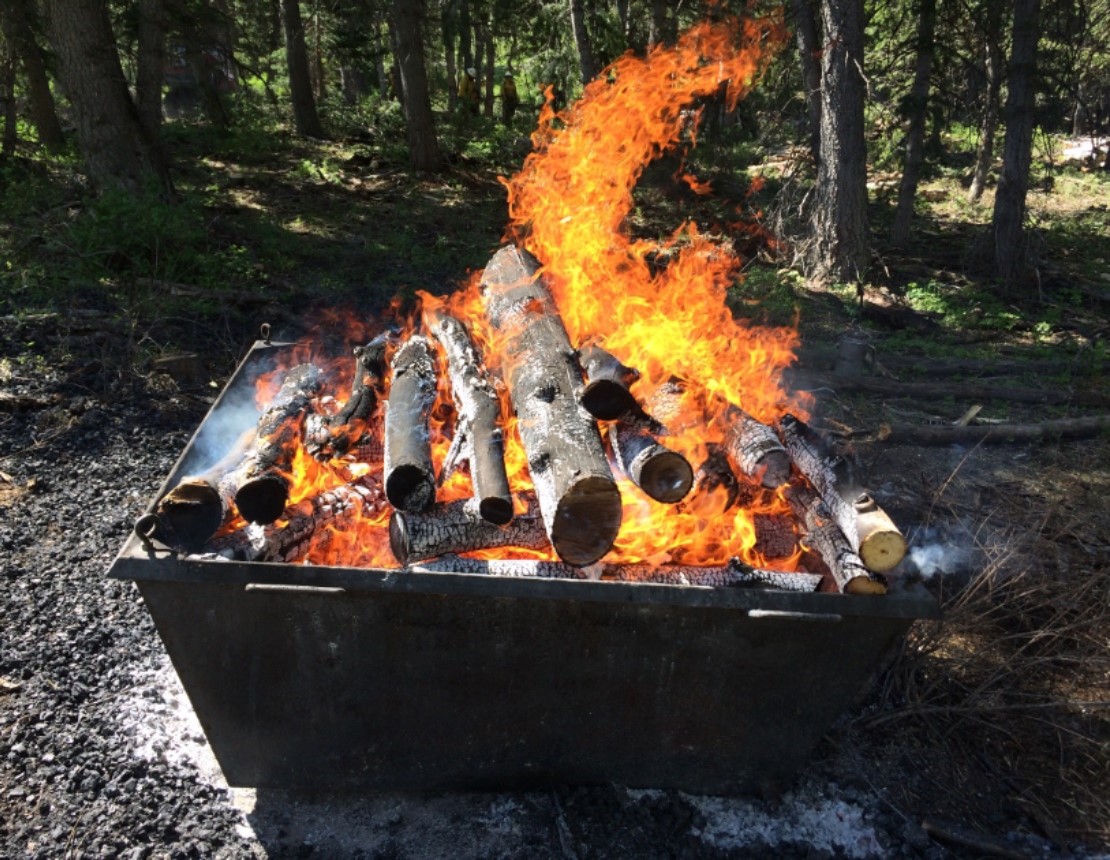

Figures 12, 13, and 14. The sequence of a typical biochar burn. Note the windscreen to reduce impact from wind in the first figure, figure 12.
Quenching
When the flames die down from flaming combustion and transition to glowing or smoldering combustion (figure 13), it is time to quench the fire. The fire should be quenched by adding enough water to wet all materials, and stirring vigorously with rakes and shovels to ensure everything is wet and extinguished (figure 14). Quenching can take up to 100 gallons of water for a 5 x 5-foot kiln. When ready to quench, fill the kiln with water and stir it with a shovel or rake. Stirring is as important as wetting. This process can be compared to making pancake batter—if you don’t stir completely, there will be dry batter left. This is important in the biochar quenching process because dry char means burning hasn’t stopped, holding the potential to ignite an unwanted fire. Failing to extinguish the fire can also result in a kiln full of ash instead of biochar. Ash is white and is a very different material (biochar is black). If any of the material is too hot to hold in your hand, it needs more water and stirring. Continue to quench with water and stir until 100% of the material is cool to the touch. The next step is to drain the kiln when all of the material in the kiln is soaked through. It is important to note that it is normal to have a few pieces of uncharred material; they can simply go into the next kiln for continued batches. If the kiln has a drain plug, pull it, or have a team of strong people team-lift and dump the kiln to empty it. A kiln full of water and char can weight up to 800 lbs.; however, our demonstrations have shown that four strong people can turn it over by hand. There are several dry quenching options when water is unavailable. One option is extinguishing the fire with soil, but this takes more time and effort. A second option includes tipping the kiln completely over onto the char pile as you empty it, leaving the kiln upside down on the pile, acting as a lid on the fire and using soil to seal the edges along the ground. A third option includes using a metal lid to snuff the fire. This approach effectively cooks the large pieces of material that did not completely turn to char. Prevention is the key to safely making biochar using these techniques. The key to safety is ensuring that all material is cool to the touch.
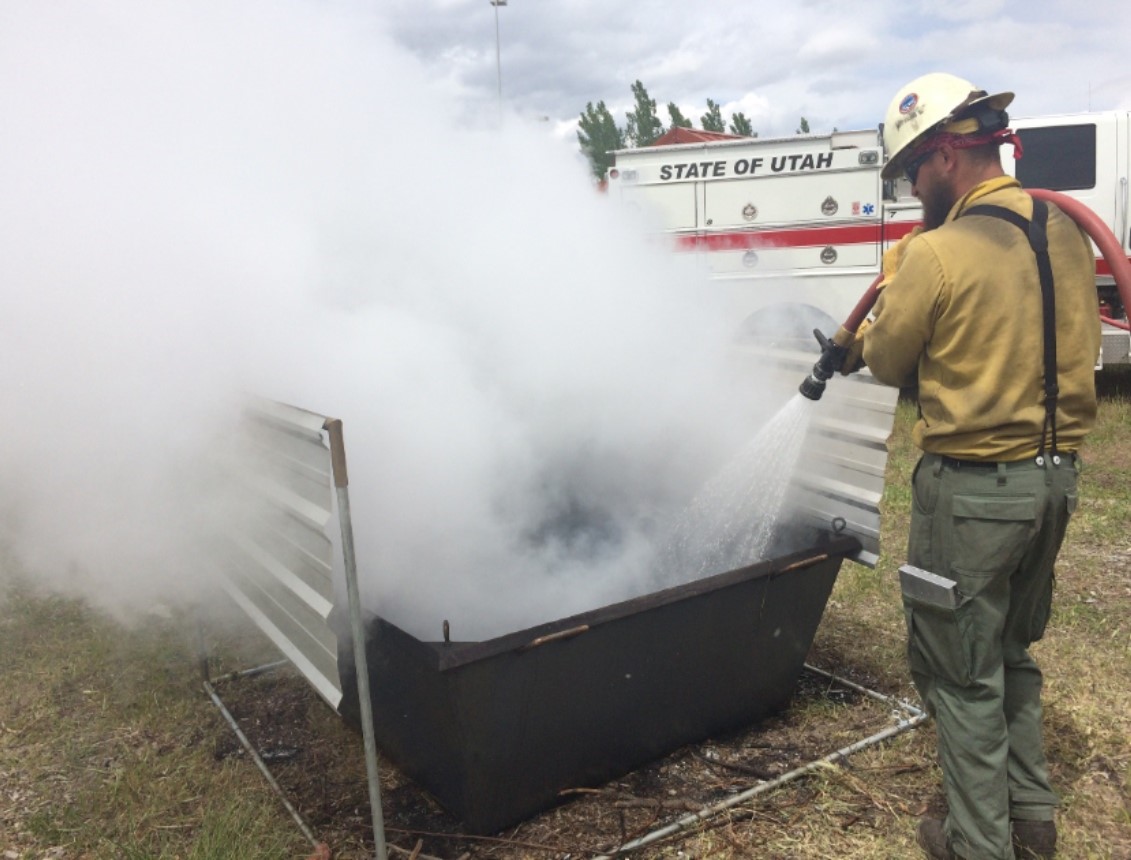


Figures 15, 16, and 17. Quenching biochar in a series of steps.
Conclusion
Biochar production in small kilns clearly does not match the scale of the hazardous fuels problem in the West today. While pile burning will likely remain the predominant practice for hazardous fuels reduction in western U.S. forests where fuels are abundant, the flame cap kiln technique is an important additional alternative with many benefits. This approach improves forest resilience by reducing hazardous fuels and protecting soils from the extreme heat pulses common with pile burning. The resulting biochar can be spread in the forest, or used or sold as a soil amendment. For more on using biochar in the forest, see our Utah Forest Fact sheet on Biochar for Forest Restoration in the Intermountain West.
The ability to bring these portable kilns to the source of the problem makes them uniquely situated to deal with the growing problem of hazardous fuel accumulation in Utah (and beyond). Learn more about our simple kiln projects on our website and by reading our impact statement.
All the images in this fact sheet are courtesy of Darren McAvoy unless otherwise noted.
Resources
- Arocena, J. M., & Opio, C. (2003). Prescribed fire-induced changes in properties of subboreal forest soils. Geoderma, 113(1–2), 1–16.
- Batista, E. M. C. C., Schultz, J., Matos, T. T. S., Fornari, M. R., Ferreria, T. M., Szpoganicz, B., Mangrich, A. S. (2018). Effect of surface and porosity of biochar on water holding capacity aiming indirectly at preservation of the Amazon biome. Nature Scientific Reports, 8 (10677), 1–9.
- Jiménez Esquilín, A. E., Stromberger, M. E., Massman, W. J., Frank, J. M., & Shepperd, W. D. (2007). Microbial community structure and activity in a Colorado Rocky Mountain forest soil scarred by slash pile burning. Soil Biology and Biochemistry, 39(5), 1111–1120.
- Karhu, K., Mattila, T., Bergström, I., & Regina, K. (2011). Agriculture, Ecosystems and Environment Biochar addition to agricultural soil increased CH 4 uptake and water holding capacity – Results from a short-term pilot field study. Agriculture, Ecosystems and Environment, 140(1–2), 309–313.
- Lal, R. (2009). Challenges and opportunities in soil organic matter research. European Journal of Soil Science, 60 (158–169).
- Tryon, E. H. (1948). Effect of Charcoal on Certain Physical , Chemical , and Biological Properties of Forest Soils. Ecological Monographs, 18(1), 81–115.
Acknowledgments
Thanks to the Utah Division of Forestry, Fire & State Lands personnel and members of an adhoc advisory committee who reviewed this fact sheet. I also thank the Extension Services of Washington State University and Pennsylvania State University for publications on timber harvesting that contributed greatly to the content of this document.
Published September 2019.

